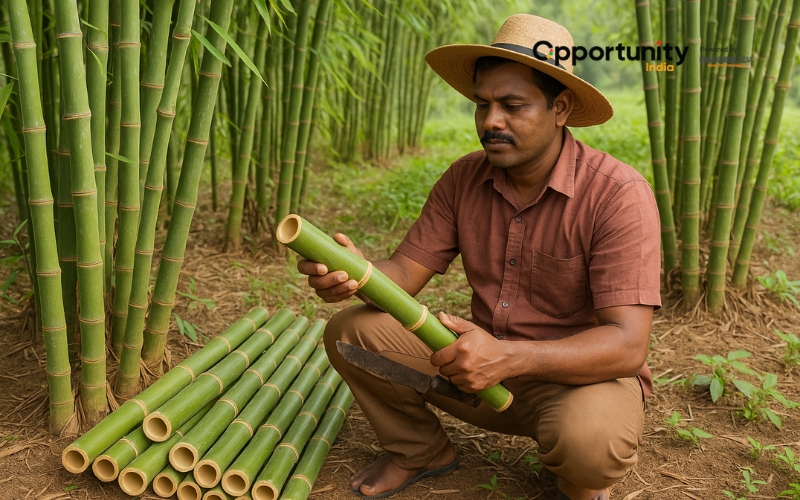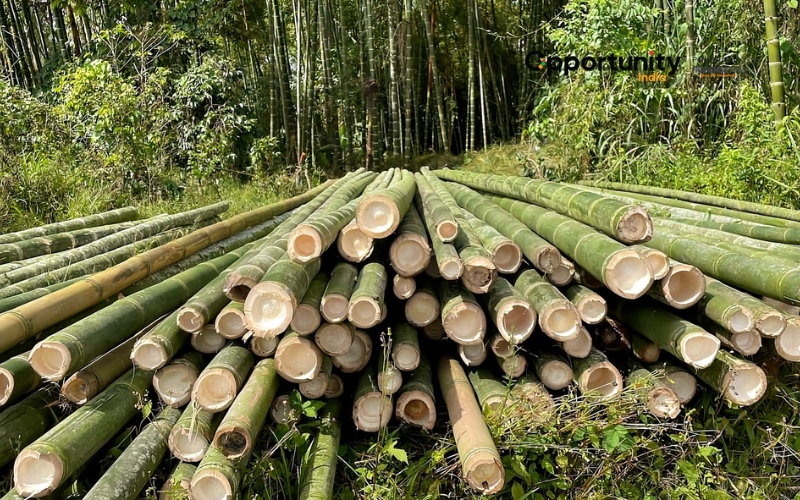
Has the idea of transforming a piece of land into a profitable, sustainable green goldmine ever crossed your mind? If not, it's time to learn more about Indian bamboo growing. Bamboo, which was formerly thought of as a poor man's lumber, is today one of the most lucrative and environmentally friendly business endeavors in modern agriculture. What's the best part? It can grow even in marginal soil and requires little maintenance. Bamboo farming may be the best option for you, whether you're an eco-aware investor or a modern farmer.
Why Bamboo Farming in India?
Bamboo farming has become one of the most promising and environmentally friendly agribusiness prospects in India due to the country's increasing demand for sustainable products and the government's encouragement of green entrepreneurship. Bamboo, which was once thought of as the "poor man's timber," is now seen as the "green gold" of the future. Bamboo can be the best choice for you if you're looking for a low-maintenance, high-profit farming solution.
Also Read: Pearl Farming in India – Process and Investment Cost
Bamboo has several advantages, ranging from substantial financial gains to environmental preservation. For Indian farmers and business owners, investing in bamboo cultivation can be a wise and secure move given the growing demand for items made from bamboo across a range of industries.
With a wide variety of bamboo species, India is the world's second-largest producer, after China. The nation has a solid basis for large-scale commercial production due to its ideal climate and traditional knowledge of bamboo use. Bamboo cultivation is becoming more popular for several reasons:
- High Demand and Versatility: Bamboo is used extensively in agriculture (bamboo shoots), furniture, handicrafts, paper, textiles, construction, biomass for electricity, and even as a plastic substitute. For farmers, this varied demand guarantees several sources of income.
- Fast Growth and High Yield: Bamboo is a woody plant that grows the fastest; some kinds can reach a height of one meter per day. When compared to traditional timber, this fast growth enables shorter harvesting cycles (usually 3-5 years for the first harvest, followed by annual harvests), providing a quicker return on investment.
- Sustainability and Environmental Advantages: Bamboo is a crop with a high degree of sustainability. It uses less water, doesn't require pesticides, and aids in groundwater recharge, carbon sequestration, and soil conservation. Bamboo is a long-term investment because a single clump can grow back for decades without needing to be replanted.
- Government Support: The Indian government actively encourages bamboo growing by offering financial support, technical advice, and market connections through programs like the National Bamboo Mission (NBM).
- Economic Opportunity: The bamboo industry has enormous potential to increase agricultural incomes and create jobs, particularly in rural areas.

Suitable Conditions for Bamboo Farming
Before planting bamboo, make sure the essential environmental parameters in your area are met.
Ideal Conditions:
| Factor | Requirement |
|---|---|
| Climate | Tropical to subtropical |
| Temperature | 15°C to 38°C |
| Rainfall | 1000 mm to 2500 mm |
| Soil | Well-drained loamy or clay loam soil |
| Land | Slight slope preferred for drainage |
Popular Bamboo Farming Varieties in India
The following bamboo species are commercially viable:
- Bambusa balcooa: Strongest and best for construction.
- Bambusa tulda: Used in the paper and pulp industry.
- Dendrocalamus asper: Large bamboo used for building and food.
- Bambusa vulgaris: Decorative, used in crafts and furniture.
- Thyrsostachys siamensis: Perfect for export and tasty shoots.
Also Read: How to Make a Profitable Hydroponic Farming Business Plan?
Bamboo Farming Process: Step-by-Step Guide
From choosing a site to harvesting and marketing, there are several important phases involved in starting a bamboo farm.
Site Selection
- Climate: Temperatures between 15°C and 40°C are ideal for bamboo growth in tropical and subtropical regions. Although 1000–3000 mm of rain per year is ideal, bamboo may be produced in dry climates with the right irrigation.
- Soil: Loamy or sandy-loamy soil that drains well and has a pH between 5.5 and 6.5 is the best. Bamboo may grow in a variety of soil types, but steer clear of rocky, waterlogged, or extremely salinized soils.
Land Preparation
Remove any rocks, weeds, and rubbish from the area. For better drainage and soil loosening, deep plowing is advised. Add organic materials to improve soil fertility, such as compost, vermicompost, or farmyard manure (FYM). Create pits of 2ft x 2ft x 2ft size at a spacing of 5x5 meters (or 4x4 meters for dense plantation).
Selecting Appropriate Bamboo Species
Choosing bamboo species that are appropriate for the agroclimatic conditions of your area and your intended end use is crucial to the success of your bamboo farm. When choosing the right species for your particular market and area, it's essential to get advice from the National Bamboo Mission or local agricultural specialists.
Planting and Propagation
It is possible to reproduce bamboo using tissue culture, culm cuttings, rhizomes, or seeds. For consistent growth and disease resistance, tissue culture plants or healthy saplings are frequently chosen.
- Planting season: Since the monsoon season (June to July) offers steady rainfall for early growth, this is typically the ideal time of year to plant.
- Spacing: For optimum growth and yield, proper spacing is essential.
- For species with thick walls and a medium diameter: 5 m × 5 m (around 160 plants per acre).
- Smaller types: 4 m × 4 m, or about 250 plants per acre.
- For larger species: at least 7 m × 7 m, or 82 plants per acre.
- Although high-density plantations are a contemporary trend, they must be managed carefully to prevent resource competition.
- Planting Technique: Plant the seedlings at the same depth as before. Make sure the earth covers the root ball completely.
Fertilization and Irrigation
- Watering: Bamboo needs steady moisture, particularly in the first one to two years after planting, as the rhizome system is growing. When there is a dry spell, weekly irrigation is advised. Bamboo becomes comparatively drought-resistant after it is established. Since it saves water and gets it straight to the roots, drip irrigation is incredibly effective.
- Fertilization: Bamboo requires a lot of fertilizer. Nutrients must be applied on a regular basis to promote healthy development and high output. Every six months, use organic fertilizers (cow dung or vermicompost). Each year, NPK fertilizers can be added in divided quantities.
Also Read: How To Start a Fish Farming Business With a Plan in India?
Maintenance and Disease/Pest Management
- Weeding: Keep weeds out of the way to avoid competing for nutrients, especially in the early stages of growth. The bamboo roof naturally inhibits the growth of weeds once it has developed.
- Mulching: Using bamboo leaves or other organic materials to mulch helps control weeds, maintain soil moisture, and regulate soil temperature.
- Pruning: To encourage healthy new branch growth and increase overall clump productivity, remove any dead, weak, or crowded culms.
- Control of Pests and illnesses: Bamboo is often immune to the majority of pests and illnesses. However, in humid environments, keep an eye out for typical pests like mites and aphids, as well as fungal infections. Sprays containing neem oil may be useful for controlling pests.

Harvesting and Post-Harvest Management
- Harvesting Period: Depending on the species, bamboo usually reaches the point of its first commercial harvest in three to five years. Harvesting mature culms (3-6 years old) ensures maximum strength and durability.
- Technique for Harvesting: Employ appropriate cutting methods to promote sustainability and ongoing regeneration. Culms should be harvested in the months that are not the monsoon or growing season.
- Treatment: To extend their lifespan and guard against insect damage, bamboo culms can be treated with borax solutions or other techniques after harvesting.
Investment Required for Bamboo Farming in India
Here’s a rough investment estimate for 1 acre of bamboo farming:
| Expense Head | Approx. Cost (INR) |
| Land Preparation | ₹10,000 |
| Bamboo Saplings (400 plants @ ₹30) | ₹12,000 |
| Pit Digging & Planting Labor | ₹10,000 |
| Organic Fertilizer & Compost | ₹8,000 |
| Drip Irrigation Setup | ₹25,000 |
| Fencing | ₹15,000 |
| Maintenance (1st year) | ₹10,000 |
| Miscellaneous | ₹5,000 |
| Total Investment (1st Year) | ₹95,000 |
Also Read: Aloe Vera Farming in India: A Business Plan
Profit and Yield from Bamboo Farming
Bamboo takes a while to grow, but once it does, the rewards are worth it.
Average Yield:
- 400 plants per acre
- Each plant produces 30 culms annually (starting in the fifth year).
- 12,000 culms annually per acre
Market Price: ₹50 to ₹150 per culm, depending on demand and species
Gross Income Estimate:
| Year | Income per Culm | Total Culms | Gross Income |
|---|---|---|---|
| 1–3 | Nil (Establishment phase) | - | ₹0 |
| 4th Year | ₹60 | 4,000 (partial harvest) | ₹2,40,000 |
| 5th Year Onwards | ₹100 | 12,000 | ₹12,00,000 annually |
Net Profit: You can anticipate making between ₹8 and 10 lakhs per acre per year starting in the fifth year, even after subtracting maintenance expenses of ₹30,000 to ₹40,000 per year.
In India, bamboo cultivation is a step toward sustainability, climatic resilience, and rural employment in addition to being an appealing business. Bamboo can turn arid territory into a green goldmine with little effort and enormous commercial potential. Whether you're an environmentally concerned businessperson, an innovative farmer, or someone seeking a long-term agri-investment, bamboo farming might be your next big thing.

